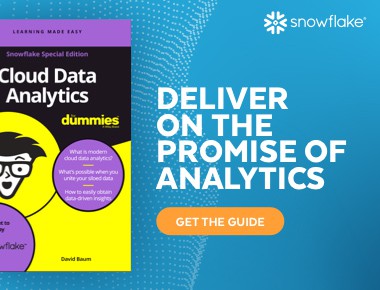Data Discovery: A Foundation for Faster Insights
With the rise of cloud applications, IoT, and third-party data marketplaces, today’s organizations have an extraordinary wealth of data available to inform business decision-making. But having massive amounts of data isn’t beneficial without a way to mine that data for insights. Data discovery helps business users quickly identify patterns, spot anomalies, and test hypotheses as a first step in the business intelligence process.
What Is Data Discovery?
Data discovery is an approach for users of all technical levels to identify relevant data available to them to enhance their data analytics. It involves collecting data from a variety of different sources and exploring what insights the data may reveal before moving forward with advanced analytics techniques such as machine learning and statistical modeling.
Data discovery is a four-step process that includes aggregating multiple data sources, transforming the data, performing visual analysis (exploratory analysis), and applying advanced analysis techniques. It may also involve sharing the data among various stakeholders to gain their unique perspectives and allow them to explore the data for insights that may bring up additional questions. As organizations move up the analytics maturity curve, data discovery becomes a crucial part of business intelligence operations.
Data discovery’s primary purpose is to make data actionable. It allows analysts, data engineers, and business users to efficiently explore data and find valuable insights to answer crucial questions and improve business outcomes from product development to sales.
Data Discovery Process
While there’s no single right way to conduct data discovery, typically the process involves four steps:
Data collection
The first step in the data discovery process is to identify which data sets are relevant to the business inquiry. For example, if a revenue team is trying to reduce customer churn, they will need to gather data that provides a 360-degree view of their customers’ interaction touchpoints, including online transaction data, website activity, advertising interactions, customer support activity, and third-party interactions relevant to their relationship with the company. All the appropriate data sets are loaded into the data warehouse or data lake.
Data preparation
ETL and ELT tools prepare the data, which involves converting data to the same format, cleansing it by removing inconsistent or inaccurate data, and other processes. During transformation, rules and functions are applied to prevent bringing in bad data.
Visual analysis
Visual analysis, or data exploration, is designed to guide further analysis. It helps decision-makers identify what questions to ask. Visual analysis gives users context and helps them to quickly see anomalies and patterns. Insights are presented in bar charts, line graphs, scatter plots, heat grids, scorecards, and other visualizations. This process allows users to identify follow-up questions, so they can then apply advanced analysis techniques.
Advanced analysis
Once business teams determine what questions to ask to guide their decision-making, they can then use techniques such as data mining and augmented analytics to comb through mountains of data in an efficient manner. With advanced analysis, much of the analytics process is automated, allowing teams to arrive at insights faster and with less manual work.
Data Discovery Use Cases
To get a clearer picture of how today’s organizations are using data discovery, let’s look at a few examples.
Retail
Data discovery can help retailers to respond more quickly to market changes. Advanced analytics techniques can be applied to customer data so that retailers can spot trends earlier and predict future demand more accurately. As a result, retailers can more effectively manage inventory, preventing unwanted goods from expiring and avoiding stockouts of high-demand products.
Finance
Financial institutions are using data discovery to prevent fraud. Analytics-powered early-warning systems mine transactional data in real time to detect fraudulent activity as it happens. Additionally, digital credit assessments and credit-collection analyses more thoroughly vet potential borrowers before extending credit, reducing risk.
Manufacturing
Manufacturers are able to more accurately predict when manufacturing equipment will need to be serviced by using data discovery. With these insights, they can avoid unplanned production outages. Additionally, running advanced analytics on real-time feeds from sensors on the manufacturing floor enables manufacturers to spot quality control issues early and correct them.
Healthcare
Healthcare providers are using data discovery to identify risk factors for certain medical conditions, giving them the ability to provide preventative treatments. Recognizing potential health issues early on and responding with appropriate interventions can dramatically improve healthcare outcomes.
Snowsight: A New Era in Data Discovery
Snowflake’s Snowsight is designed to support rapid data exploration. With features such as autocomplete, automatic data profiling, visualizations, dashboards, and collaboration, users can quickly identify outliers and quality issues as well as write queries faster.
Snowsight was developed for analysts, data engineers, and business users alike. With Snowsight, you can easily find and connect to data both inside and outside your organization, speed up data preparation and analysis, quickly visualize results, prototype dashboards, and share insights with your team.
See how Snowflake customers are using Snowsight and learn more about what Snowsight can do for your team.

